人教版七年级下册 Unit3 SectionB 2a-2c 教学设计(全英文版)
文档属性
| 名称 | 人教版七年级下册 Unit3 SectionB 2a-2c 教学设计(全英文版) |
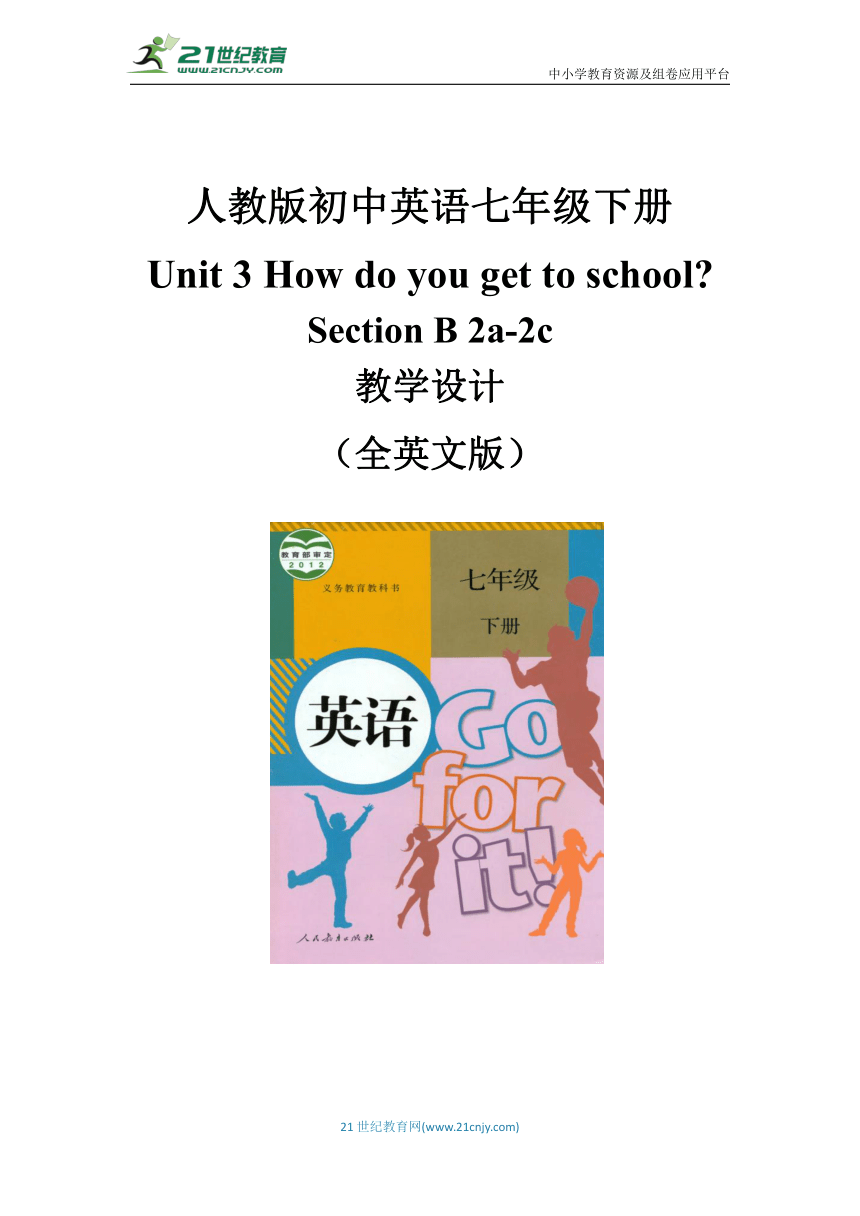
|
|
| 格式 | zip | ||
| 文件大小 | 1.7MB | ||
| 资源类型 | 试卷 | ||
| 版本资源 | 人教新目标(Go for it)版 | ||
| 科目 | 英语 | ||
| 更新时间 | 2023-03-17 14:21:27 | ||
图片预览

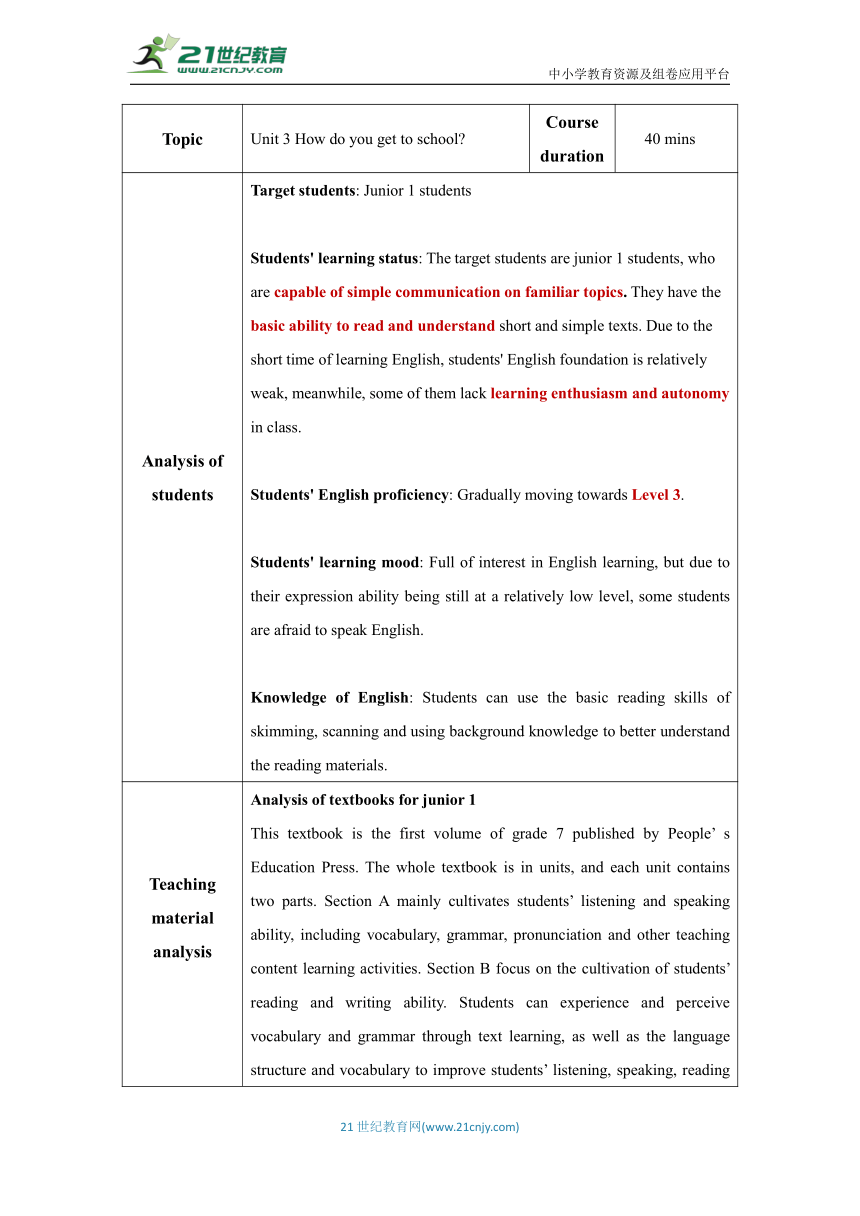
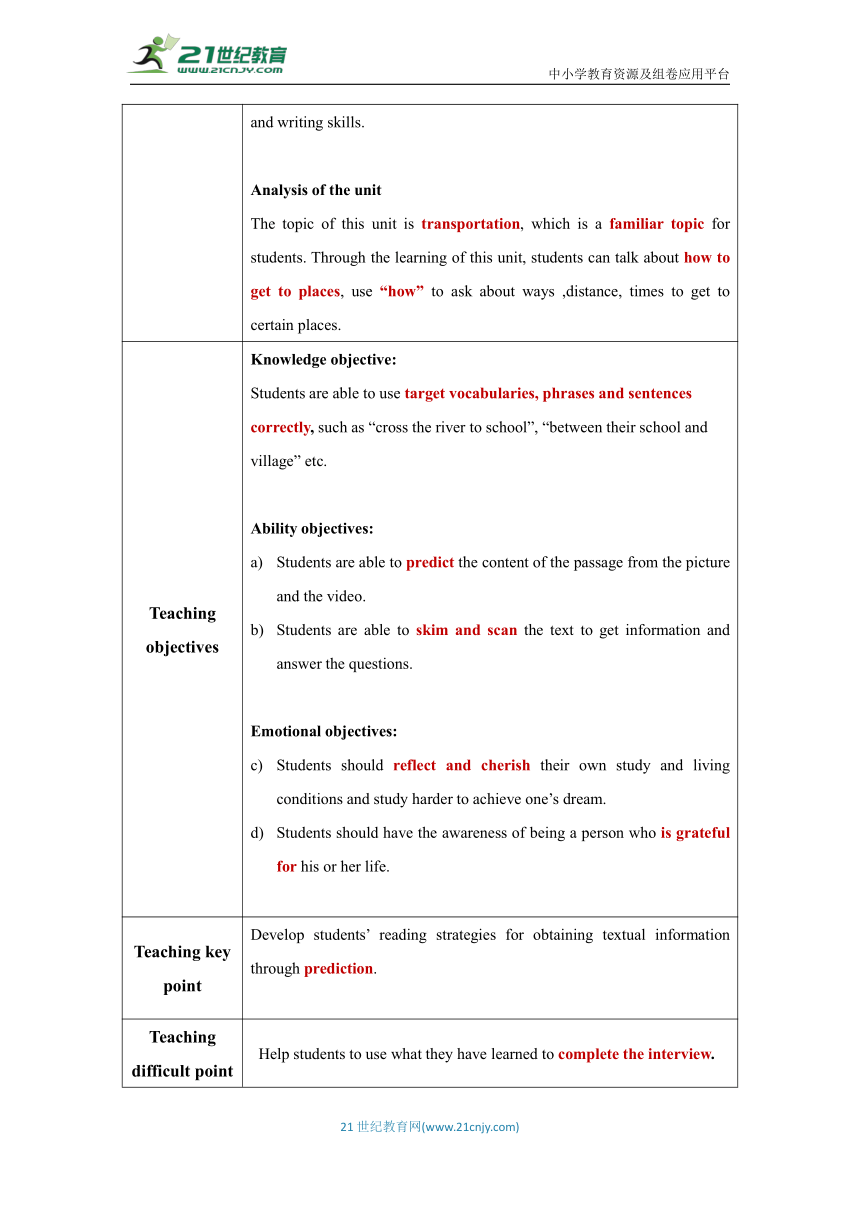
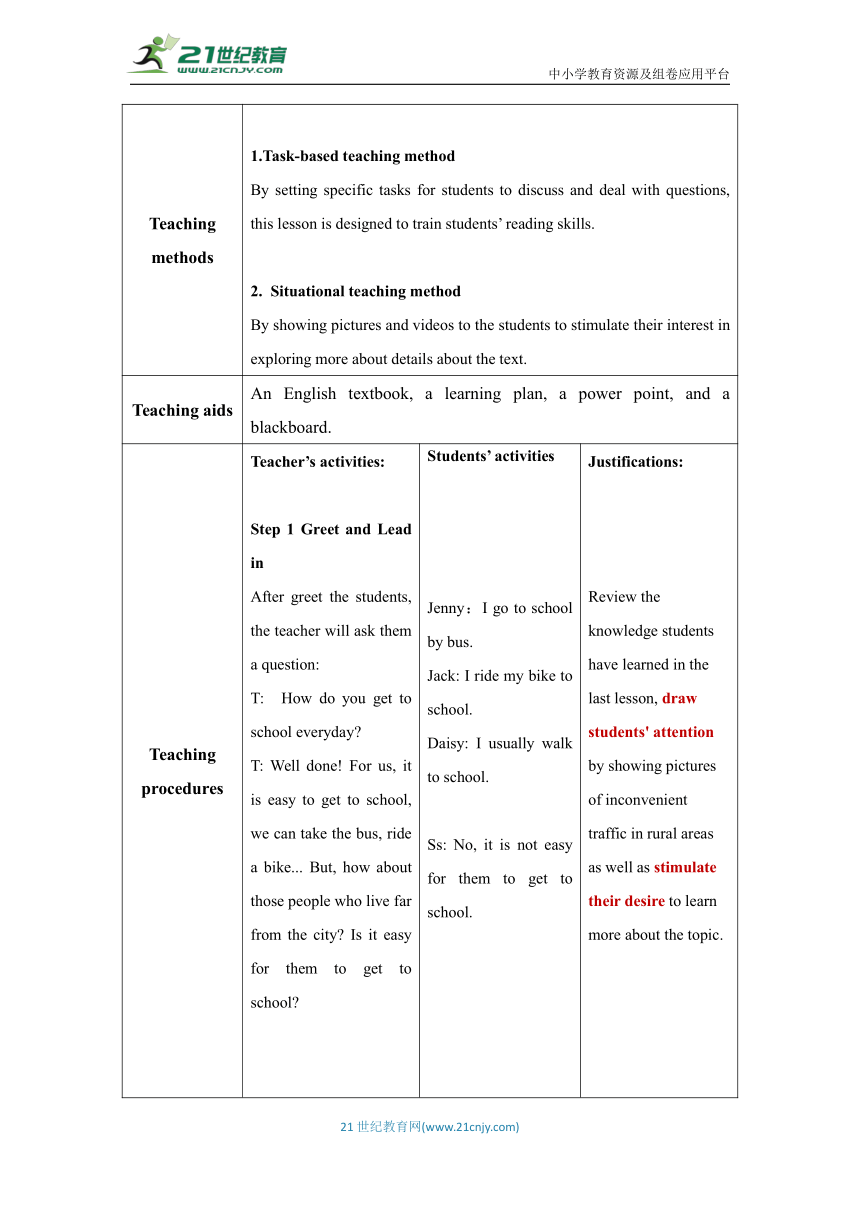
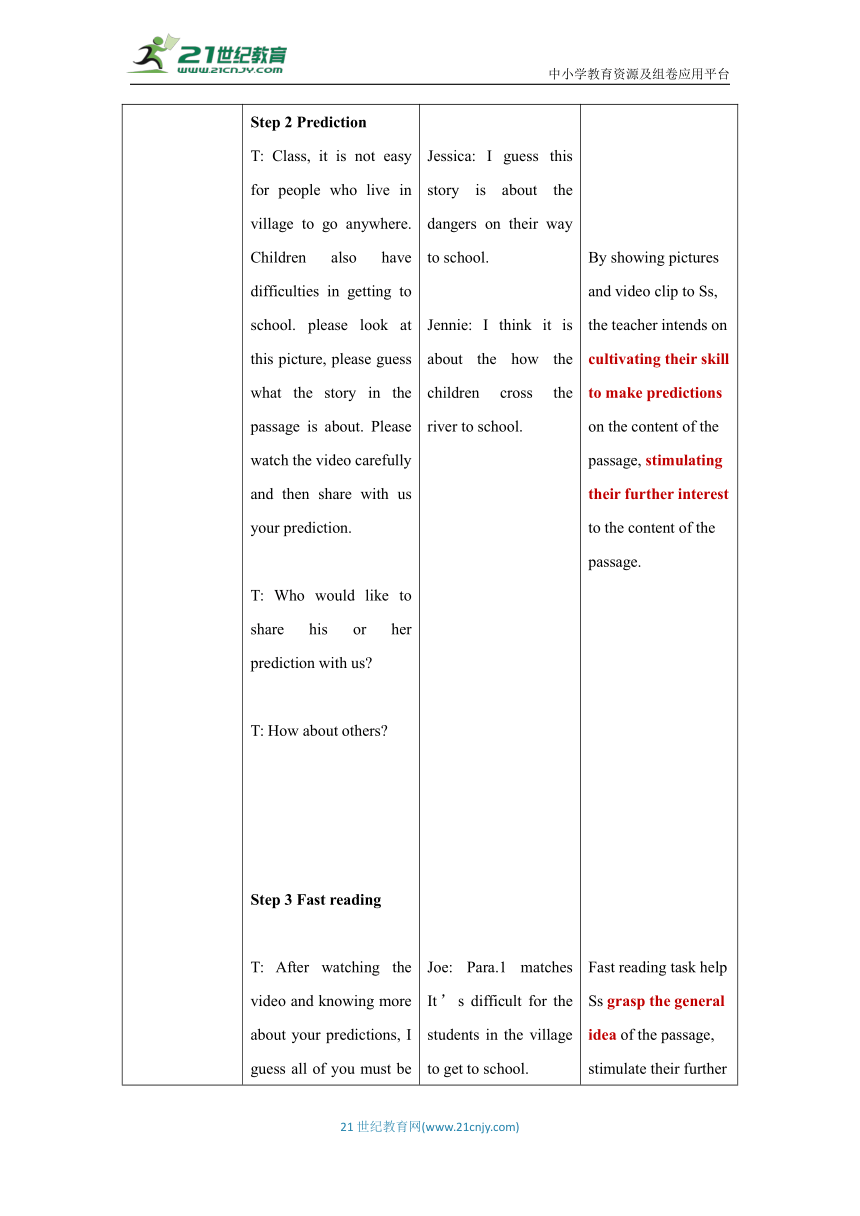
文档简介
中小学教育资源及组卷应用平台
人教版初中英语七年级下册
Unit 3 How do you get to school
Section B 2a-2c
教学设计
(全英文版)
Topic Unit 3 How do you get to school Course duration 40 mins
Analysis of students Target students: Junior 1 studentsStudents' learning status: The target students are junior 1 students, who are capable of simple communication on familiar topics. They have the basic ability to read and understand short and simple texts. Due to the short time of learning English, students' English foundation is relatively weak, meanwhile, some of them lack learning enthusiasm and autonomy in class.Students' English proficiency: Gradually moving towards Level 3.Students' learning mood: Full of interest in English learning, but due to their expression ability being still at a relatively low level, some students are afraid to speak English.Knowledge of English: Students can use the basic reading skills of skimming, scanning and using background knowledge to better understand the reading materials.
Teaching material analysis Analysis of textbooks for junior 1This textbook is the first volume of grade 7 published by People’ s Education Press. The whole textbook is in units, and each unit contains two parts. Section A mainly cultivates students’ listening and speaking ability, including vocabulary, grammar, pronunciation and other teaching content learning activities. Section B focus on the cultivation of students’ reading and writing ability. Students can experience and perceive vocabulary and grammar through text learning, as well as the language structure and vocabulary to improve students’ listening, speaking, reading and writing skills.Analysis of the unitThe topic of this unit is transportation, which is a familiar topic for students. Through the learning of this unit, students can talk about how to get to places, use “how” to ask about ways ,distance, times to get to certain places.
Teaching objectives Knowledge objective:Students are able to use target vocabularies, phrases and sentences correctly, such as “cross the river to school”, “between their school and village” etc.Ability objectives: Students are able to predict the content of the passage from the picture and the video.Students are able to skim and scan the text to get information and answer the questions.Emotional objectives:Students should reflect and cherish their own study and living conditions and study harder to achieve one’s dream.Students should have the awareness of being a person who is grateful for his or her life.
Teaching key point Develop students’ reading strategies for obtaining textual information through prediction.
Teaching difficult point Help students to use what they have learned to complete the interview.
Teaching methods 1.Task-based teaching methodBy setting specific tasks for students to discuss and deal with questions, this lesson is designed to train students’ reading skills.Situational teaching method By showing pictures and videos to the students to stimulate their interest in exploring more about details about the text.
Teaching aids An English textbook, a learning plan, a power point, and a blackboard.
Teaching procedures Teacher’s activities:Step 1 Greet and Lead inAfter greet the students, the teacher will ask them a question:T: How do you get to school everyday T: Well done! For us, it is easy to get to school, we can take the bus, ride a bike... But, how about those people who live far from the city Is it easy for them to get to school Step 2 PredictionT: Class, it is not easy for people who live in village to go anywhere. Children also have difficulties in getting to school. please look at this picture, please guess what the story in the passage is about. Please watch the video carefully and then share with us your prediction.T: Who would like to share his or her prediction with us T: How about others Step 3 Fast readingT: After watching the video and knowing more about your predictions, I guess all of you must be very interested about this passage. Now please read this passage for the first time and finish the exercise on the PPT. You will be given 1.5minutes to finish this task. T: Have you finish it Who wants to have a try Step4 Detail readingT: Now please Read Para.1 carefully and fill in the blanks. T: Read Para.2 carefully and answer the questions.Q1: How does Liangliang get to school Q2: What does Liangliang think of his school and his teacher T: Read Para.3 carefully and answer the question.What is the villagers’ dream Do you think it can come true How can it come true T: Class, actually the government have build a bridge for the villagers in the video clip. But unfortunately , the little boy Wawa’s sister has lost her life when going on the ropeway. Now let’s continue watching the rest of the video clip.(Show students the video clip) Step5 InterviewingT: Class, now please imagine that you are a reporter, you are going to interview Wawa, please make up a conversation.T: Now I’ d like to share my idea with you, I want two volunteers to act this dialogue out, any volunteers Step 6: Story sharing The teacher share with the students the story about the “ice boy” and ask about their feelings after today’ class.Step6: HomeworkT: Ask students to read the passage by themselves and record it down to the Wechat group.Watch the movie Walking to school, write down your feelings and be ready to share it with us the next class. Students’ activitiesJenny:I go to school by bus.Jack: I ride my bike to school.Daisy: I usually walk to school.Ss: No, it is not easy for them to get to school.Jessica: I guess this story is about the dangers on their way to school.Jennie: I think it is about the how the children cross the river to school.Joe: Para.1 matches It’s difficult for the students in the village to get to school.Sandy: Para.2 matches Liangliang crosses the river to school everyday but he is not afraid.Judy: Para.3 matches The students and villagers have a dream. Jack: There is a big river between their school and village.Eliot: There is no bridge. David: The river runs too quickly for boats.Jessica: He goes on a ropeway to cross the river to school.Monica: He loves the school and his teacher. The teacher is like a father to him. Davy: Their dream is to have a bridge. I think their dream can come true. Maybe the government can build a bridge for them.Ss: Make their own conversations.Jennie: How do you get to school now, Wawa Jack: I walk to school. Sometimes I ride my bike....Monica: I think I should study hard and try to help others.Jennie: I think we should have our own dream and try hard to make it come true. Justifications:Review the knowledge students have learned in the last lesson, draw students' attention by showing pictures of inconvenient traffic in rural areas as well as stimulate their desire to learn more about the topic.By showing pictures and video clip to Ss, the teacher intends on cultivating their skill to make predictions on the content of the passage, stimulating their further interest to the content of the passage.Fast reading task help Ss grasp the general idea of the passage, stimulate their further interest on the content of the passage.Detail reading helps Ss get specific information in the passage, especially the reason why it is not easy for children live in the village to get to school, this can also help them better understand the passage.This activity enables Ss to speak their ideas out. The teacher creates a situation where the Ss act as the reporter to interview the movie character in the video clip, which can not only stimulate their imagination, but also encourage them to talk about the passage in their own way.This step is set to further cultivate students’ awareness of being a person who is grateful to his or her life, being a person who always lend a helping hand to others.Ask students to get more information about the passage, write their ideas and share with the class.
Blackboarddesign Unit 3 How do you get to school It is + adj. + to do sth. between … and … year-oldbe afraid of
HYPERLINK "http://www.21cnjy.com/" 21世纪教育网(www.21cnjy.com)
人教版初中英语七年级下册
Unit 3 How do you get to school
Section B 2a-2c
教学设计
(全英文版)
Topic Unit 3 How do you get to school Course duration 40 mins
Analysis of students Target students: Junior 1 studentsStudents' learning status: The target students are junior 1 students, who are capable of simple communication on familiar topics. They have the basic ability to read and understand short and simple texts. Due to the short time of learning English, students' English foundation is relatively weak, meanwhile, some of them lack learning enthusiasm and autonomy in class.Students' English proficiency: Gradually moving towards Level 3.Students' learning mood: Full of interest in English learning, but due to their expression ability being still at a relatively low level, some students are afraid to speak English.Knowledge of English: Students can use the basic reading skills of skimming, scanning and using background knowledge to better understand the reading materials.
Teaching material analysis Analysis of textbooks for junior 1This textbook is the first volume of grade 7 published by People’ s Education Press. The whole textbook is in units, and each unit contains two parts. Section A mainly cultivates students’ listening and speaking ability, including vocabulary, grammar, pronunciation and other teaching content learning activities. Section B focus on the cultivation of students’ reading and writing ability. Students can experience and perceive vocabulary and grammar through text learning, as well as the language structure and vocabulary to improve students’ listening, speaking, reading and writing skills.Analysis of the unitThe topic of this unit is transportation, which is a familiar topic for students. Through the learning of this unit, students can talk about how to get to places, use “how” to ask about ways ,distance, times to get to certain places.
Teaching objectives Knowledge objective:Students are able to use target vocabularies, phrases and sentences correctly, such as “cross the river to school”, “between their school and village” etc.Ability objectives: Students are able to predict the content of the passage from the picture and the video.Students are able to skim and scan the text to get information and answer the questions.Emotional objectives:Students should reflect and cherish their own study and living conditions and study harder to achieve one’s dream.Students should have the awareness of being a person who is grateful for his or her life.
Teaching key point Develop students’ reading strategies for obtaining textual information through prediction.
Teaching difficult point Help students to use what they have learned to complete the interview.
Teaching methods 1.Task-based teaching methodBy setting specific tasks for students to discuss and deal with questions, this lesson is designed to train students’ reading skills.Situational teaching method By showing pictures and videos to the students to stimulate their interest in exploring more about details about the text.
Teaching aids An English textbook, a learning plan, a power point, and a blackboard.
Teaching procedures Teacher’s activities:Step 1 Greet and Lead inAfter greet the students, the teacher will ask them a question:T: How do you get to school everyday T: Well done! For us, it is easy to get to school, we can take the bus, ride a bike... But, how about those people who live far from the city Is it easy for them to get to school Step 2 PredictionT: Class, it is not easy for people who live in village to go anywhere. Children also have difficulties in getting to school. please look at this picture, please guess what the story in the passage is about. Please watch the video carefully and then share with us your prediction.T: Who would like to share his or her prediction with us T: How about others Step 3 Fast readingT: After watching the video and knowing more about your predictions, I guess all of you must be very interested about this passage. Now please read this passage for the first time and finish the exercise on the PPT. You will be given 1.5minutes to finish this task. T: Have you finish it Who wants to have a try Step4 Detail readingT: Now please Read Para.1 carefully and fill in the blanks. T: Read Para.2 carefully and answer the questions.Q1: How does Liangliang get to school Q2: What does Liangliang think of his school and his teacher T: Read Para.3 carefully and answer the question.What is the villagers’ dream Do you think it can come true How can it come true T: Class, actually the government have build a bridge for the villagers in the video clip. But unfortunately , the little boy Wawa’s sister has lost her life when going on the ropeway. Now let’s continue watching the rest of the video clip.(Show students the video clip) Step5 InterviewingT: Class, now please imagine that you are a reporter, you are going to interview Wawa, please make up a conversation.T: Now I’ d like to share my idea with you, I want two volunteers to act this dialogue out, any volunteers Step 6: Story sharing The teacher share with the students the story about the “ice boy” and ask about their feelings after today’ class.Step6: HomeworkT: Ask students to read the passage by themselves and record it down to the Wechat group.Watch the movie Walking to school, write down your feelings and be ready to share it with us the next class. Students’ activitiesJenny:I go to school by bus.Jack: I ride my bike to school.Daisy: I usually walk to school.Ss: No, it is not easy for them to get to school.Jessica: I guess this story is about the dangers on their way to school.Jennie: I think it is about the how the children cross the river to school.Joe: Para.1 matches It’s difficult for the students in the village to get to school.Sandy: Para.2 matches Liangliang crosses the river to school everyday but he is not afraid.Judy: Para.3 matches The students and villagers have a dream. Jack: There is a big river between their school and village.Eliot: There is no bridge. David: The river runs too quickly for boats.Jessica: He goes on a ropeway to cross the river to school.Monica: He loves the school and his teacher. The teacher is like a father to him. Davy: Their dream is to have a bridge. I think their dream can come true. Maybe the government can build a bridge for them.Ss: Make their own conversations.Jennie: How do you get to school now, Wawa Jack: I walk to school. Sometimes I ride my bike....Monica: I think I should study hard and try to help others.Jennie: I think we should have our own dream and try hard to make it come true. Justifications:Review the knowledge students have learned in the last lesson, draw students' attention by showing pictures of inconvenient traffic in rural areas as well as stimulate their desire to learn more about the topic.By showing pictures and video clip to Ss, the teacher intends on cultivating their skill to make predictions on the content of the passage, stimulating their further interest to the content of the passage.Fast reading task help Ss grasp the general idea of the passage, stimulate their further interest on the content of the passage.Detail reading helps Ss get specific information in the passage, especially the reason why it is not easy for children live in the village to get to school, this can also help them better understand the passage.This activity enables Ss to speak their ideas out. The teacher creates a situation where the Ss act as the reporter to interview the movie character in the video clip, which can not only stimulate their imagination, but also encourage them to talk about the passage in their own way.This step is set to further cultivate students’ awareness of being a person who is grateful to his or her life, being a person who always lend a helping hand to others.Ask students to get more information about the passage, write their ideas and share with the class.
Blackboarddesign Unit 3 How do you get to school It is + adj. + to do sth. between … and … year-oldbe afraid of
HYPERLINK "http://www.21cnjy.com/" 21世纪教育网(www.21cnjy.com)
同课章节目录
- Unit 1 Can you play the guitar?
- Section A
- Section B
- Unit 2 What time do you go to school?
- Section A
- Section B
- Unit 3 How do you get to school?
- Section A
- Section B
- Unit 4 Don't eat in class.
- Section A
- Section B
- Unit 5 Why do you like pandas?
- Section A
- Section B
- Unit 6 I'm watching TV.
- Section A
- Section B
- Review of Units 1-6
- Unit 7 It's raining!
- Section A
- Section B
- Unit 8 Is there a post office near here?
- Section A
- Section B
- Unit 9 What does he look like?
- Section A
- Section B
- Unit 10 I'd like some noodles.
- Section A
- Section B
- Unit 11 How was your school trip?
- Section A
- Section B
- Unit 12 What did you do last weekend?
- Section A
- Section B
